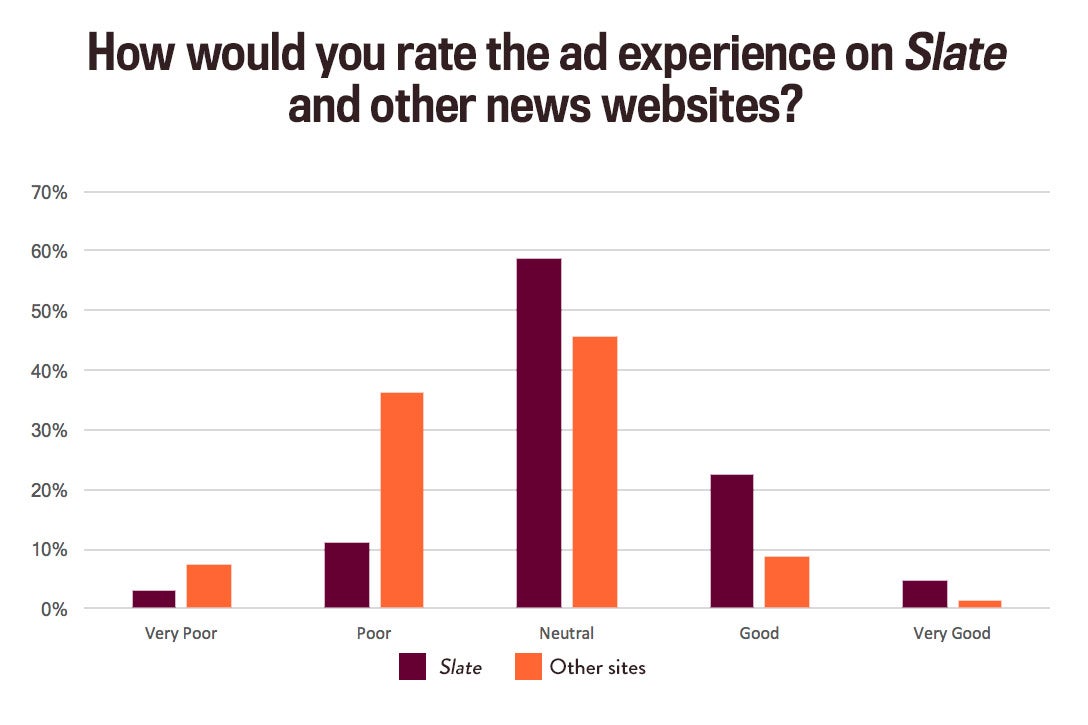The success of Slate’s business rests primarily on three elements: an editorial product that helps readers and listeners to understand the world with fresh, thoughtful analysis and a distinctive voice; a loyal readership, many of whom now support Slate through our membership program; and advertisers who want to reach our audience and associate their brands with our own.
We believe it’s critically important to maintain a consistent strategy that aligns these three drivers of our business and that this must rely on a reading and listening experience that respects both our readers and our advertisers. That’s why Slate strives to be as smart about our advertising as we are about our editorial content.
The digital advertising industry has generally aimed to grab readers’ attention at any cost, even at the expense of reader experience. Many publications have forgotten what it means to create a valuable advertising experience, forcing readers to ignore ads or turn to ad blockers.
Slate has taken a different path. Earlier this year, the Coalition for Better Ads released new standards based on research on which types of ad experiences users found most disturbing and intrusive. Google announced that the Chrome browser, which accounts for the majority of web traffic, would soon begin to filter out ads that violated these standards. Because we had already established our own high standards internally, none of our ad experiences violate the standards Chrome is setting. This change will have no impact on Slate—except that it reduces the supply of low-quality ad inventory across the web, hopefully shifting aggregate demand toward the higher-quality ad experiences we serve.
Last year, we removed Outbrain ads, the click-baity headlines from “Around the Web,” from the bottom of our article pages. Before the removal, we conducted a user survey solely around Slate’s ad experience. Eighty-one percent of readers rated Slate’s ad experience as “neutral” or “good.” In comparison, just over half of readers (54 percent) give other news websites similar rankings.

In this year’s annual audience survey, after the removal of Outbrain, we found that 22 percent of Slate readers report never being interrupted by an ad (up 5 percent since October 2016), 66 percent are sometimes interrupted by ads (down 3 percent from October 2016), and 12 percent are always interrupted by ads (down 2 percent from October 2016).
The core metric our editorial team has focused on this year is total engaged minutes, which measures how much time visitors spend on the site. Keying off of this, we’re focused on maximizing revenue per engaged minute. This metric rewards us for getting readers to stay on our site—we have to earn the right to show them more ads by producing content that keeps them there. We don’t care if users read 10 short articles, one long article, or never leave the home page, as long as they’re spending time actively engaging with our content.
If we instead focused on maximizing revenue per page view, as many of our peers do, we might write click-bait headlines, build salacious slideshows, reinstate pagination, or jam as many ads as possible on the first screen you see before scrolling down the page. Instead, we rely on engaging pieces to pull readers farther down the page, then weave advertising at regular frequencies into the content.
And we hope to make the advertising experience on Slate even better. Early next year, we’re launching a redesigned site. Some features on the new article layouts, like the one you’re on right now, will stick around. For example, all our video ad formats are autoplay muted and give users the clear ability to unmute, pause, or play video to avoid disruption. Our ad units will continue to have clear “ADVERTISING” labels above them and will have borders and spacing to indicate that they’re not part of editorial content. Our design team has worked tirelessly to ensure that all our ads look great on both mobile and desktop versions. And all ads that run on the top of the page will have a maximum height of 250 pixels to make sure the page won’t shift when the ad loads.
After we launch the new site in 2018, there will be no more ads along the right-hand side of Slate. (Ads that appear in line with content ensure higher engagement rates.) Ad-insertion logic will be based on word counts, rather than on paragraphs, to ensure that the share of pixels on any given page that is devoted to ads is consistent. Because our inventory varies so much across the site and over the course of the year, we wanted to make sure the design was flexible enough to support different types of ads. Each ad position will be able to serve both the industry-standard ad sizes compatible with programmatic networks and the bespoke, high-impact ad units that we develop and sell ourselves.
We’re working hard to encourage our advertisers to think creatively about how they promote their brands on Slate. We don’t allow just any ad to run on our site, especially if it’s going to be bad for reader experience. Our goal is to make sure that our advertising experience is just as captivating as our editorial experience. So whether you’re a loyal Slate reader, you work in digital advertising, or you’re a writer, we’d love to know what you think about the ad experience on our new layout. Join in the discussion in the comments, or send us a note at feedback@slate.com.
